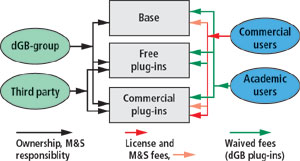 Technology from Europe: Technology from Europe:
the Netherlands
A new paradigm for cross-disciplinary software development
Fred Aminzadeh and Paul de Groot , dGB-Group
OpendTect is an open-source software system, originally designed for seismic analysis, visualization and interpretation. It enables geologists and geophysicists to process, visualize and interpret multivolume seismic data using attributes and modern visualization techniques such as stereo viewing and volume rendering. With its open-source structure, it is not only a functional interpretation system, it is also an environment for seismic analysis.
Systems programmers can develop their own tools as system plug-ins. The software is currently supported on PC-Linux, Sun-Solaris, SGI-Irix and MS Windows (2000/NT/XP). Heavy processing of large volumes can be carried out in batch mode on multiple machines. The Windows version is currently stand-alone.
In the petroleum industry, Seismic-Unix or SU is an open-source software package, maintained by the Colorado School of Mines. SU has been used by many as a platform for R&D work on seismic processing, and many commercial entities use it in conjunction with their software products. OpendTect is probably the first Open Source software in the oil industry that originates from a successful commercial product by a service company, the dGB-Group (de Groot Bril).
 |
Development and business model for OpendTect.
|
|
The development and business model for OpendTect requires that the base system is developed, owned and maintained by dGB, and is free of charge to all R&D users. Both dGB and other developers can develop plug-ins and release these as free or commercial plug-ins via the download center of the OpendTect website (www.opendtect.org), see accompanying figure.
While the open-source aspect of the system is similar to that of SU, the functionalities (processing vs. interpretation) as well as the general objectives (academic vs. business strategy) are quite different. Currently, the main features are: multivolume attributes; spectral decomposition; integrated processing and visualization allowing on-the-fly calculations and analysis; distributed computing on existing hardware; plug-in architecture that allows new functionality to be added at runtime; and horizon and fault mapping (coming soon).
The base system can be extended with the following commercial plug-ins: dip-steering, which allows creating/ using steering cubes for advanced attributes and filters; neural networks, for creating “meta attributes”; and workstation access, for direct import/ export to and from other seismic interpretation systems.
Dip-steering and neural networks are the basis of Statoil's seismic object detection method, in which meta attributes are created from different seismic attributes and interpreters' knowledge to isolate specific geologic features. Carefully selected combinations of seismic attributes and filters and non-linear mapping by the neural network help reveal subtle information from multiple seismic volumes.
OpendTect, with its meta attribute feature has been used extensively for many applications including prediction of salt bodies, highlighting gas chimneys and fluid migration paths, identifying lithologies (sand channels, sheet sands, levees, shale), detecting faults and fractures and generally enhancing data by dip-steered median filtering. Currently, the focus is to establish the technology as a de facto standard for developing seismic interpretation tools and using it for specialized seismic interpretation and analysis.
Aside from oil industry applications with seismic data focus, the technology has the potential to become a platform for many non-seismic applications within the oil industry. Moreover, it can be used by general geophysics-related applications outside the oil industry such as earthquake seismology, environmental remediation, mining, remote sensing and ground water resource management. In principle, it can be used for any problem in connection with interactive analysis of 3D data volumes. See World Oil, May/June 2001 for a complete article on the neural network and gas chimney aspects of this software. 
|

 Technology from Europe:
Technology from Europe:

